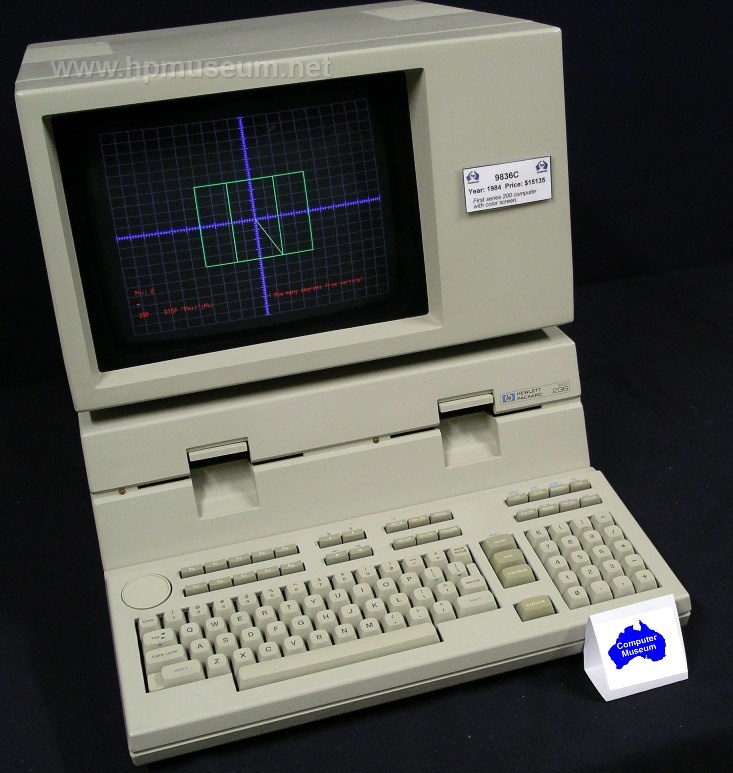Technical Desktops - Accessories
 | 200 Series Selection: |
| 1) 98256A 256K RAM Module (1981) | |
| 2) 98622A GPIO Interface (1981) | |
| 3) 98626A RS-232C Interface (1981) | |
| 4) 98624A HP-IB Interface (1981) | |
| 5) ROM BASIC 2.0 for 200 Series (1981) | |
| 6) ROM HPL 2.0 for 200 Series (1981) | |
| 7) 98620 DMA Controller (1981) | |
| 8) 98254A 64KB RAM Module (1981) | |
| 9) 9888A I/O Expander (1982) | |
| 10) 98627A RGB Monitor Interface (1982) | |
| 11) 98691A Prog Serial Interface (1982) | |
| 12) 98629A SRM Interface (1982) | |
| 13) 98203 Keyboard (1982) | |
| 14) 98028A Resource Mgmt MUX (1982) | |
| 15) 9816 Tilt/Swivel (1982) | |
| 16) 98630-66502 DIO Extender (1982) | |
| 17) 98625A Disc Interface (1983) | |
| 18) 35721 Monitor (1983) | |
| 19) 98628A Data Comm Interface (1983) | |
| 20) 98201A Keyboard Interface (1983) | |
| 21) 98204 Mono Video Interface (1983) | |
| 22) 98259A Bubble Memory (1983) | |
| 23) 98623A BCD Interface (1983) | |
| 24) 98255A EPROM card (1983) | |
| 25) 98253A EPROM Developer Kit (1983) | |
| 26) 98644A RS-232C Interface (1984) | |
| 27) 98640A Analog to Digital Converter (1984) | |
| 28) 98635A Floating Point Board (1984) | |
| 29) 98781A Monitor (1984) | |
| 30) 98630A Breadboard Interface (1984) | |
| 31) 98257A 1 MB RAM Module (1985) | |
| 32) 98642A 4-port MUX (1985) | |
| 33) 46021 HP-HIL Keyboard (1985) | |
| 34) 98603A BASIC 4.0 ROM (1985) | |
| 35) 50962A SRM Interface (1986) | |
| 36) 98603B BASIC 5.1 ROM (1988) | |
HP introduced its 200 Series with the 9826 in 1981. The 200 Series machines were HP's high-end technical desktops and were based on the new Motorola 68000 processor (clock speeds of 8 MHz or 12.5 MHz). HP had six models in this range including the rack-mountable 9920 and 9837. All 200 Series machines came with HP-IB interfaces and none offered the option of a built-in printer. The early 200 Series machines featured BASIC, Pascal and HPL (providing some compatibility with the 9825 ). The high-performance models also offered HP-UX, FORTRAN and assembly language. The 200 Series went through three naming/numbering cycles. The first machine was born as the 9826, became the "200 Series Model 26" and retired as the "HP 9000 Model 226" . Before the 200 Series, all previous HP desktop computers (80 Series, 98X5 Series, 98X0 Series) used pluggable hardware ROMs to expand the language/processing capabilities of the computer. The 200 Series used RAM-based operating systems and languages (with the exception of the optional ROM-based HPL and BASIC ROM boards). All subsequent HP desktop computers also used RAM-based operating systems and languages. These products were developed and manufactured at HP's Desktop Computer Division.
Ansgar Kuekes has created an amazing utility for allowing a modern PC to emulate disc drives for the 200 Series computers. To run "hpdrive", you only need a GPIB card for your PC and an HP-IB cable: HPDrive. Using Ansgar's "HPDir" utility, you can use your PC to perform disc operations on the old software (copy discs, transfer files, etc): HPDir. Be sure to visit Olivier De Smet's emulator project for 200 Series computers. The museum has a collection of software available for download for these computers. Click here for the software listing. | |
| Back |
^ TOP©2004 - 2024 BGImages Australia - All Rights Reserved.
The HP Computer Museum and BGImages Australia are not affiliated with HP Inc. or with Hewlett Packard Enterprise. Hewlett Packard and the HP logo are trademarks of HP Inc and Hewlett Packard Enterprise. This website is intended solely for research and education purposes.
